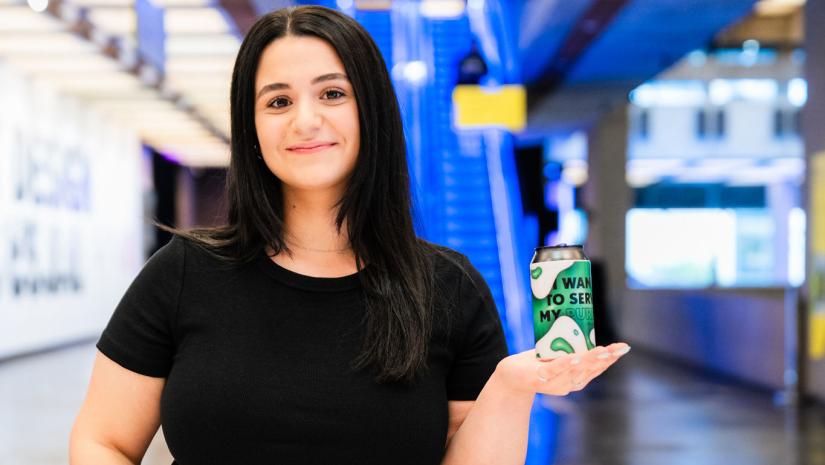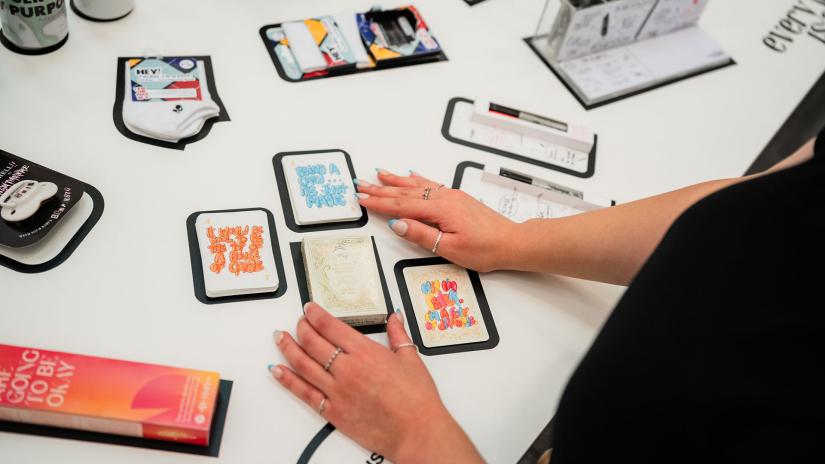Gabriella Annetta
The Visual Communication student is bringing inanimate objects to life.

When Visual Communication student Gabriella Annetta started planning her honours project, she didn’t just want to create something that looked beautiful.
Instead, inspired by the Everything is Alive podcast, where the host interviews a different inanimate object each episode, Gabriella took a deep dive into the inner lives of everyday things.
“From a can of cola to a pregnancy test, the podcast is about imagining a life and livelihood for these objects,” Gabriella says.
“I ended up creating a speculative packaging series, which looks at the process of anthropomorphism to inform all my design decisions.”
Anthropomorphism is the attribution of human traits to non-human things, including inanimate objects. Gabriella selected nine episodes of the podcast and analysed the lives, desires and stories that had been assigned to each object.
She then created packaging pieces for each item that, instead of advertising its function, showcased its speculative life instead.
One example? A generic can of cola named Louis whose lifelong dream is to be consumed by a human.
“I used quotes and type a lot throughout the packaging, so for him I had really big text that said, ‘I want to serve my purpose’,” Gabriella says.
“I used something called thermochromic ink, which appears or disappears depending on the temperature. So when the can is full in the fridge, it’s quite colourful and different messages are visible.
“However, when the can becomes warm — aka when a consumer finally drinks it — the design becomes very stark and simple, black and white, and the type changes to show Louis’s process of being able to fulfil what he’s wanted to do all his life.”
It might be unconventional, but the work was more than just a gimmick — Gabriella says the goal was to inspire people to interact with their surroundings in ways that we might otherwise forget to do.
“We live in such an egocentric and technology-based modern day, so being able to engage with our surroundings in a way that we unknowingly neglect was really interesting to me,” she says.

She presented the project at the 2023 Design Honours showcase, a vibrant event which welcomed industry representatives, including Buck, Mighty Nice and Houston Group, alongside family and friends to view the final Honours projects.
But, while the Design Honours showcase was a highlight, it was far from Gabriella’s first interaction with the world of design — the Bachelor of Design in Visual Communication offers extensive interaction with industry, including live briefs, internships and other practice-based learning opportunities.
Among these is a third-year subject called Socially Responsive Design. As well completing a compulsory internship, students are called on to deliver design solutions in response to a real-world client brief.
Gabriella was part of a group paired with Naiteev, a social enterprise that repurposes automotive plastic waste into golf tees and coasters. She and her team were asked to create a series of coaster designs, as well as new packaging for the products.
The experience helped build Gabriella’s confidence as a designer, as well as her experience working on industry briefs.
When it comes to project briefs at uni, you can kind of bend them a bit to suit what you really want to do. This was a good chance to put aside any personal bias and really make sure you're meeting the requirements of your client. They trust us as students to be able to create a project that addresses their real life needs and wants for their own business.
Undertaking the year-long Design Honours program has further helped Gabriella to find her niche as a designer. “I felt like that really allowed you to experiment and decide what type of design you really enjoy,” she says.
She’s now leaving UTS with an internship under her belt, as well as a professional portfolio and the confidence of leading a unique Honours project.
